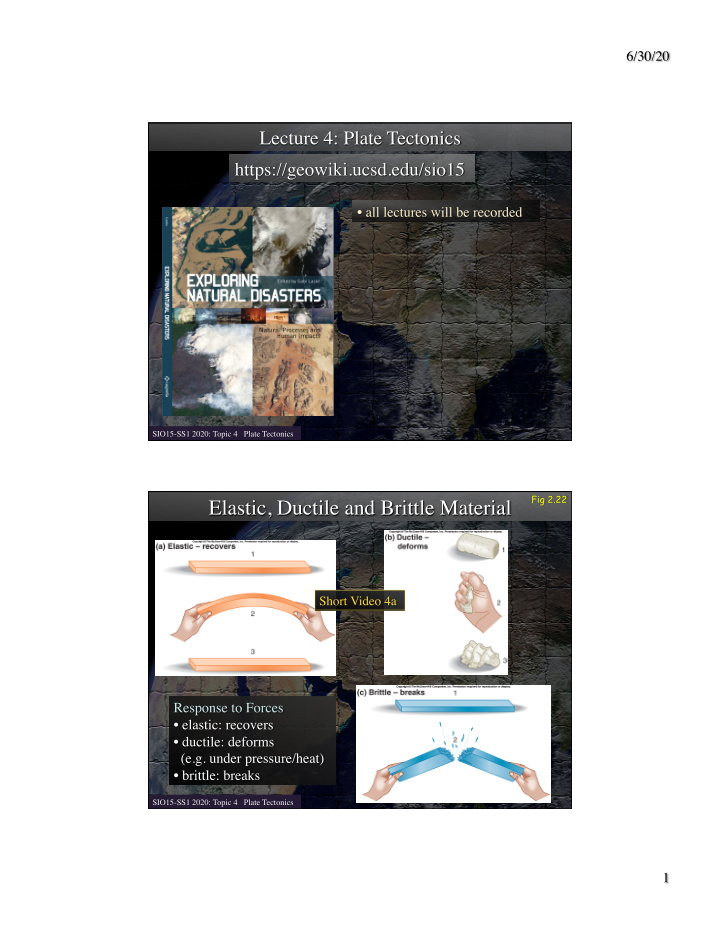



SIO15-SS1 2020: Topic 4 Plate Tectonics SIO15-SS1 2020: Topic 4 Plate Tectonics
SIO15-SS1 2020: Topic 4 Plate Tectonics Lithosphere • cool and strong but brittle • zone of Eqs/volcanoes Asthenosphere • warm, soft, ductile Image: S. Marshak “Earth, Portrait of a Planet” SIO15-SS1 2020: Topic 4 Plate Tectonics
Why do continents have roots? What keeps the lithosphere afloat? SIO15-SS1 2020: Topic 4 Plate Tectonics SIO15-SS1 2020: Topic 4 Plate Tectonics
2 counteracting forces • gravity • buoyancy isostatic equilibrium • forces are balanced Image: S. Marshak “Earth, Portrait of a Planet” • body floats � rigid lithosphere floats on soft asthenosphere � asthenosphere reacts to imbalance (flows) SIO15-SS1 2020: Topic 4 Plate Tectonics • lithosphere is broken up into 12 major plates • move about (a few cm per year) • divergent • driven by mantle convection • convergent • transform Mendocino Triple Junction SIO15-SS1 2020: Topic 4 Plate Tectonics Image: P. Abbott “Natural Disasters”
SIO15-SS1 2020: Topic 4 Plate Tectonics a little bit like this • ductile mantle (video 4a) • viscosity: resistance to flow (Lecture 2 notes) Image: S. Marshak “Earth, Portrait of a Planet” SIO15-SS1 2020: Topic 4 Plate Tectonics
SIO15-SS1 2020: Topic 4 Plate Tectonics slab pull ridge push slab pull slab pull more dominant SIO15-SS1 2020: Topic 4 Plate Tectonics
• lith. formed at MORs • lith. consumed in subduction zones • same rate • plates move a few cm/yr • earthquakes • volcanism • mountain building and other features on Earth’s surface SIO15-SS1 2020: Topic 4 Plate Tectonics How do we know that plates move sideways? • Alfred Wegener, 1915 • continents like jigsaw puzzle • fossil records match across oceans • geologic units match across oceans • apparent polar wander curves don’t match SIO15-SS1 2020: Topic 4 Plate Tectonics
What Makes Continents Drift? continental drift (Alfred Wegener 1915) sea floor observations (Harry Hess 1950s) - sea floor deepens away from mid-ocean ridges (MORs) - sediments thicken away from MORs - heat flow is greater at MORs than elsewhere - dredging (ocean rock different from continental rocks) - earthquakes along MORs -> seafloor cracking map by Heezen and Tharp SIO15-SS1 2020: Topic 4 Plate Tectonics Fig. 4.14 • magnetic anomalies no oceanic lith. older than 200 Mio yrs • ocean deep drilling -> subduction zones Dietmar Mueller, SIO SIO15-SS1 2020: Topic 4 Plate Tectonics
SIO15-SS1 2020: Topic 4 Plate Tectonics • magnetic north 2000 at: Shape: 81.5ºN, 111.4ºW like that of bar magnet (dipole) Observables: strength, declination, inclination Origin: currents in metallic liquid outer core -> magnetic dynamo Time Evolution: changing field; reversals SIO15-SS1 2020: Topic 4 Plate Tectonics
Curie Temperature (~ 500ºC) above: domains align with mag. field below: domains frozen Image: S. Marshak “Earth, Portrait of a Planet” • rock freezing from magma record current field Source: Wikipedia • Earth’s field/rock position change over time (record of magn. field) SIO15-SS1 2020: Topic 4 Plate Tectonics Fig. 4.13 • mapping of magnetic anomalies (1960s) - ship tows magnetometer - records magnetic anomalies (Earth field+magnetized rock) - new lava cools below Curie T - current magnetic N frozen into rock - rock moves away from ridge - symmetric patterns SIO15-SS1 2020: Topic 4 Plate Tectonics
• New lithosphere at MOR pushes plates apart • thickens, cools, gets dense • loses buoyancy • more likely to subduct • sinking slabs pull rest of lithosphere behind it SIO15-SS1 2020: Topic 4 Plate Tectonics
Recommend
More recommend